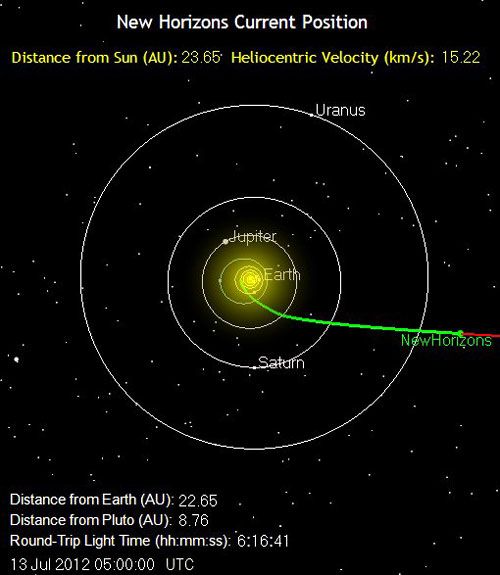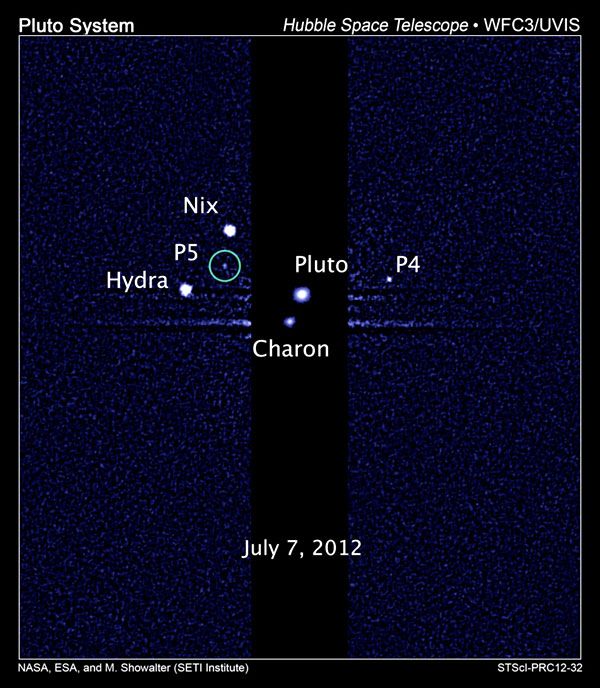
ABOVE: The green line marks the path traveled by the New Horizons spacecraft as of
10:00 PM, Pacific Daylight Time, on July 12, 2012. It is 2.1 billion miles from Earth.
Click here to view the official webpage showing where New Horizons is in space.
(AU stands for Astronomical Units, in case you're wondering.)
New Horizons Update... The flight team for NASA's Pluto-bound mission should both be thrilled and annoyed at the Hubble Space Telescope's recent discovery, which was announced on Wednesday. The team should be thrilled in that the number of celestial bodies for New Horizons to observe at the Pluto system (beginning in January of 2015) is slowly increasing. The team should also be annoyed in that this new satellite will force the Pluto close-encounter sequence for July 14, 2015 (which the spacecraft rehearsed out in deep space last May) to be revised. Of course, the team should also be concerned about how crowded (and dangerous) the space around Pluto has become now that it has 5 known moons orbiting it. And there may possibly be a potential 6th satellite revolving around the former 9th planet from the Sun as well...if speculation on the Web turns about to be true. (I'm well aware of the fallacy of that comment.)
****
Hubble Discovers a Fifth Moon Orbiting Pluto (Press Release - July 11)
A team of astronomers using NASA's Hubble Space Telescope is reporting the discovery of another moon orbiting the icy dwarf planet Pluto.
The moon is estimated to be irregular in shape and 6 to 15 miles across. It is in a 58,000-mile-diameter circular orbit around Pluto that is assumed to be co-planar with the other satellites in the system.
"The moons form a series of neatly nested orbits, a bit like Russian dolls," said team lead Mark Showalter of the SETI Institute in Mountain View, Calif.
The discovery increases the number of known moons orbiting Pluto to five.
The Pluto team is intrigued that such a small planet can have such a complex collection of satellites. The new discovery provides additional clues for unraveling how the Pluto system formed and evolved. The favored theory is that all the moons are relics of a collision between Pluto and another large Kuiper belt object billions of years ago.
The new detection will help scientists navigate NASA's New Horizons spacecraft through the Pluto system in 2015, when it makes an historic and long-awaited high-speed flyby of the distant world.
The team is using Hubble's powerful vision to scour the Pluto system to uncover potential hazards to the New Horizons spacecraft. Moving past the dwarf planet at a speed of 30,000 miles per hour, New Horizons could be destroyed in a collision with even a BB-shot-size piece of orbital debris.
"The discovery of so many small moons indirectly tells us that there must be lots of small particles lurking unseen in the Pluto system," said Harold Weaver of the Johns Hopkins University Applied Physics Laboratory in Laurel, Md.
"The inventory of the Pluto system we're taking now with Hubble will help the New Horizons team design a safer trajectory for the spacecraft," added Alan Stern of the Southwest Research Institute in Boulder, Colo., the mission's principal investigator.
Pluto's largest moon, Charon, was discovered in 1978 in observations made at the United States Naval Observatory in Washington, D.C. Hubble observations in 2006 uncovered two additional small moons, Nix and Hydra. In 2011 another moon, P4, was found in Hubble data.
Provisionally designated S/2012 (134340) 1, the latest moon was detected in nine separate sets of images taken by Hubble's Wide Field Camera 3 on June 26, 27, and 29, 2012 and July 7 and 9, 2012.
In the years following the New Horizons Pluto flyby, astronomers plan to use the infrared vision of Hubble's planned successor, NASA's James Webb Space Telescope, for follow-up observations. The Webb telescope will be able to measure the surface chemistry of Pluto, its moons, and many other bodies that lie in the distant Kuiper Belt along with Pluto.
The Pluto team members are M. Showalter (SETI Institute), H.A. Weaver (Applied Physics Laboratory, Johns Hopkins University), and S.A. Stern, A.J. Steffl, and M.W. Buie (Southwest Research Institute).
Source: HubbleSite.org
****

NEW HORIZONS Blog Entries Archive:
September 26, 2005
December 19, 2005
January 7, 2006
January 17, 2006
January 19, 2006
April 12, 2006
June 15, 2006
February 27, 2007
October 22, 2007
June 8, 2008
October 23, 2008
March 18, 2011
January 20, 2012
July 13, 2012

No comments:
Post a Comment